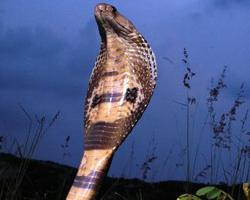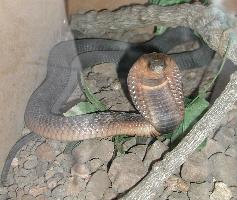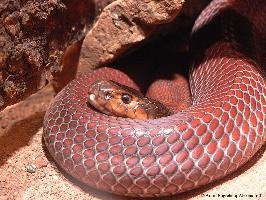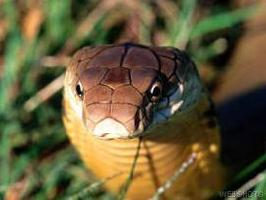
Veszélyeztetettség
| Rettenthetetlen |
Állatleírás
The Indian Cobra, scientifically named Naja naja, is a highly venomous snake species native to the Indian subcontinent. This fascinating reptile is part of the Elapidae family, which is known for its potent venom and includes some of the world's most dangerous snakes. The Indian Cobra has captured the imagination and reverence of various cultures across its native range, playing a significant role in mythology, religion, and folklore.Physical Description:
The Indian Cobra is a medium-sized snake, with adults typically reaching lengths of around 1 to 1.5 meters, though some specimens can grow up to 2 meters. Its body is robust and muscular, allowing for swift and agile movement. The skin of the Indian Cobra is smooth, with scales that vary in color from brown, black, yellow, to creamy white, often featuring distinctive patterns that can include bands, spots, or speckles. One of the most iconic features of the Indian Cobra is its hood, which it expands when threatened or displaying aggression. This hood is created by the extension of the ribs behind the snake's head, and it often features a unique spectacle pattern, resembling a pair of eyes or spectacles, which is where one of its common names, "spectacled cobra," comes from.
Habitat and Distribution:
The Indian Cobra is versatile in its habitat preferences, thriving in a variety of environments such as forests, plains, agricultural lands, and even populated urban areas, provided there is sufficient cover and food supply. It is predominantly found throughout the Indian subcontinent, including countries like India, Pakistan, Bangladesh, Sri Lanka, and Nepal.
Behavior and Diet:
The Indian Cobra is primarily nocturnal, hunting at night for its prey. It has a varied diet that includes rodents, frogs, birds, and other small mammals. Its keen sense of smell and exceptional night vision aid in tracking down prey. When confronted or threatened, the Indian Cobra can display a range of defensive behaviors, including hissing, spreading its hood to appear larger and more intimidating, and if necessary, delivering a venomous bite.
Venom:
The venom of the Indian Cobra is a potent neurotoxin, capable of causing severe pain, swelling, paralysis, and even death if not treated promptly. The snake uses its venom primarily for hunting, immobilizing its prey quickly and efficiently. However, when threatened by humans or larger predators, it can deliver a defensive bite. Antivenom is available and highly effective in treating Indian Cobra bites if administered in time.
Conservation Status:
The Indian Cobra is currently listed as Least Concern by the International Union for Conservation of Nature (IUCN), indicating that it is not currently at risk of extinction in the wild. However, it faces threats from habitat destruction, road accidents, and persecution due to fear of its venom. In some areas, Indian Cobras are also captured for the illegal wildlife trade, particularly for their skins and for use in traditional medicines.
Cultural Significance:
The Indian Cobra holds a significant place in the cultural and religious landscape of the Indian subcontinent. It is revered in Hindu mythology as a symbol of power and fearlessness, often associated with the gods Shiva and Vishnu. The practice of snake charming, though now illegal and discouraged in many places, was traditionally associated with the Indian Cobra, showcasing the deep-rooted fascination and reverence humans have for this majestic serpent.
In conclusion, the Indian Cobra is a remarkable species, known for its distinctive appearance, potent venom, and the complex relationship it shares with humans. Despite its feared status, it plays a crucial role in the ecosystems of the Indian subcontinent, acting as both a predator and a source of fascination and reverence in human culture.
Hasonló állatok
Új állatfotók
Top 10 állat
- Dolphin gull (Leucophaeus scoresbii)
- Diana monkey (Cercopithecus diana)
- Moustached guenon (Cercopithecus cephus)
- Galápagos tortoise (Geochelone nigra complex)
- Japanese macaque (Macaca fuscata)
- Stone loach (Barbatula barbatula)
- Russian tortoise (Testudo horsfieldii)
- Greek tortoise (Testudo graeca)
- Common flying dragon (Draco volans)
- Vendace (Coregonus albula)


